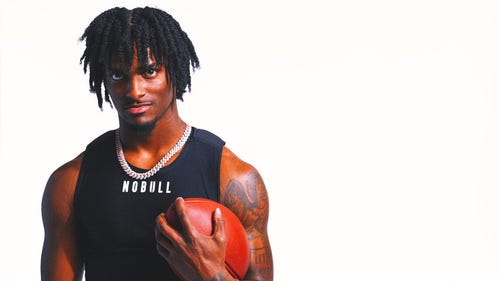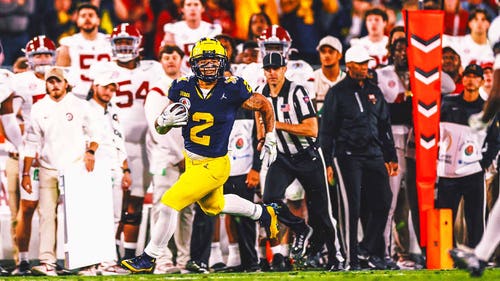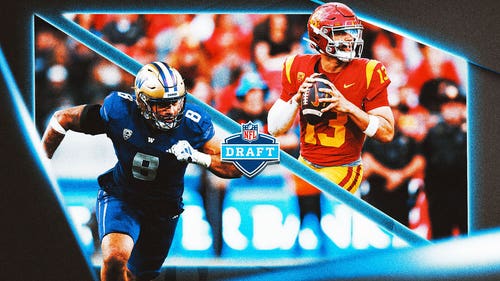
Adrian Peterson needs a miracle to break Emmitt Smith's rushing record

Adrian Peterson, the 31-year-old Minnesota Vikings running back, recently told Peter King of The MMQB that he thinks he can play at a "high level" until he's 40 years old and spoke of various goals (a title being at the top of the list) that included his desire to "break Emmitt's [Smith's career rushing] record and Eric Dickerson's [single-season rushing] record." Are these just frivolous comments or does AP actually have a chance at playing until he's 38 or beyond (he admitted 40 might be a bit much), break Emmitt Smith's career rushing record and finally getting to Dickerson, whose record he missed by eight yards in 2012? We'll take the last part first.
1. Can Adrian Peterson break Eric Dickerson's 32-year-old single-season rushing record?
Long story short: There are better odds of actual Vikings pillaging Minneapolis. The biggest reason why Peterson likely can't surpass that mark (and it's a recurring theme throughout this post) is that running backs fall off a cliff once they hit 30.

(David Madison/Getty Images)
• Only three of the top 100 rushing seasons have been put together by running backs who were 31 years old, as Peterson will be this year. They are:
• Only four more of the top 100 seasons are by players who were 30 (so 7% of the best 100 seasons are by a runner in his 30s.) The best season by a 32-year-old running back was by Walter Payton in '86, when he ran for 1,333 yards in his second-to-last season. That Payton season is the only one by a 32-year-old to make the top 250 in NFL history.
Barring a miracle, this means Peterson has one somewhat-realistic shot to pass Dickerson: this season. In doing so, he'd have to rush for 345 more yards than he had in his second-best rushing season (the second of his career, when he was 23) and 400 more yards than in his average full season.

(Focus on Sport/Getty Images)
• Improvement is tough to come by at this age. Curtis Martin, who has the best season for a 31-year-old, improved 389 yards from his 30-year-old year, a rarity for backs that age. A similar improvement for Peterson would get him to 1,874 yards, still more than 200 away from Dickerson. The big difference: Martin had 371 carries that year. Peterson has never had more than 368 and that was 2008. Almost every 31-year-old back we looked at had fewer yards at 31 than at 30.
Of the 23 men to rush for more than 1,000 yards as a 30 year old, 19 had a lower total the next season (some by a huge margin). Of the four who improved, only Martin was more than 150 yards better.
• If Peterson were to maintain his 4.5 Y/A average, something that's been pretty steady throughout his career, minus the outlying 2012 season when he went over 2,000 yards, he would need 468 carries to break the mark. There have only been five 400-carry seasons in NFL history, all by rushers 26 or younger. The record is 416, by Larry Johnson in 2006.

(Christian Petersen/Getty Images)
• So forget about getting anywhere near 400 carries. Let's give Peterson 360 carries - which is very generous, especially with a team that'll theoretically be trying to keep its older RB fresh for this year and beyond. With that total, Peterson would need to average 5.6 yards every time he touches the ball. He's only done that once in a full season (2012, obviously). In the Super Bowl era, only two players aged 31 have even rushed for more than 5.1 yards per attempt (as starting running backs). James Brooks had 5.61 Y/A on his 221 carries in 1989 and Fred Taylor has 5.4 Y/A on his 223 carries in 2007. Notice the low carry totals. The best Y/A for a 31-year-old who carried the ball more than 250 times was Tiki Barber's 5.1 in 2006. The average Y/A for the 10 players in the Super Bowl era who've done so is 4.4.
• In short (well, I guess not short - that was a long, though definitive, way of getting here), Peterson isn't getting close to Dickerson.
Prediction: Best-case scenario, Peterson gets between 1,700 and 1,800 yards in 2016. It's all downhill from there.
2. Can AP break Emmitt Smith's record?

(Photo by Joe Robbins/Getty Images)
• Peterson has 11,675 yards right now, 6,680 yards behind Smith's mark. He's gotten through the prime of his career and, as shown above, is now in the place running backs go to die, and yet he's still not even two-thirds of the way there. Overall, Smith had 18,355 in his 15 year NFL career, improving on Walter Payton's previous record by about 1,600 yards.
• Where does that leave Peterson? Through his 30-year-old season, Smith led Peterson by more than 2,000 yards (he had 13,963 at that point). That alone is a big enough strike against AP's chances. But it gets worse. From age 31-35, Smith had 4,392 yards. Rushing for a similar total would put Peterson 2,300 yards behind Smith's career mark.
• Those 6,680 yards Peterson needs to pass Smith is a total that itself would be 69th in NFL history and more than guys such as Brian Westbrook, Arian Foster, Larry Johnson, Ray Rice, Jonathan Stewart, Duce Staley and Reggie Bush had in their careers.

(Wesley Hitt/Getty Images)
Is that doable? No one else in history has come close. In the Super Bowl era, Emmitt Smith's age 31+ rushing total is the second highest, behind only John Riggins, who had 4,530 yards running behind Joe Gibbs' Hogs after turning 31. (Riggo was 33 when he had his famous Super Bowl run in 1983 and because of numerous reasons we'll get to in a minute, is not a viable comparison for AP.) As such, Peterson would need to set the record for rushing yards by an age 31+ RB by more than 2,000 yards to beat Smith. Keeping in mind the 6,680 number, here's how insane that would be:
After Riggins and Smith, here's are the age 31+ career rushing totals for other Hall of Famers

(Ronald C. Modra/Sports Imagery/Getty Images)
Only 16 rushers have gone over 2,000 yards for their career after turning 31. (Eric Dickerson only had 1,356!) Just 47 players have ever had 1,000 yards at Peterson's age. The highest non-Hall of Famer on the list is Ricky Williams, whose 2,897 yards rank him 6th.
• We bring up Williams because his is an interesting case, as he was thought to be a "young" 31-year-old after missing almost all the 2006 and 2007 seasons because of suspension, retirement or weedatical. Peterson, of course, was suspended almost the entirety of the 2014 season while facing child-abuse charges.
However, a running back doesn't get old because of the calendar, he gets old because the calendar is usually tied to the amount of carries he's gotten and hits he's received. At some point (and it usually comes quickly), as we've seen, your body doesn't allow you to produce the speed, tackle-breaking or desire to be a top back.

(Chris Graythen/Getty Images)
That's why the most carries after turning 31 is 1,250 (by Riggins, as you might expect). Emmitt Smith had 1,1166 and Marcus Allen had 1,062. Nobody else has more than 800.
• Though Peterson has that missed season, he's no spring chicken when it comes to carries. He's already 27th on the NFL career attempt list with 2,381 rushes. He was a high-school star in Texas 5A football (the big leagues) and, though he battled injuries at Oklahoma, still had over 4,000 yards in college. His odometer isn't low just because he missed 15 games in 2014.

(Adam Bettcher/Getty Images)
That's why it's ridiculous to think he'd carry the ball that much more than Riggins, Smith or Allen. Yes, AP didn't look 30 at all last year but, as we've said, running backs get old very quickly.
• It's not insulting to say that Adrian Peterson is not the greatest running back who's ever lived and, for now, it's not wrong to say he's not one of the best who ever lived either. This stat blows the mind:
AP has two 1,500+ yard seasons, the same as Curtis Martin, Shaun Alexander, Priest Holmes, Earl Campbell and Larry Johnson
Players with three such seasons: Emmitt Smith, Walter Payton, Jim Brown, O.J. Simpson, LaDainian Tomlinson, Clinton Portis, Terrell Davis and Tiki Barber.
Players with four seasons: Eric Dickerson and Edgerrin James (!)
Player with five seasons: Barry Sanders.

(Robert B. Stanton/NFLPhotoLibrary)
That's not the end-all/be-all of evaluating a running back and is an admittedly arbitrary cutoff. Looking it at a different way, Peterson has seven 1,000-yard seasons, which ties him for 12th overall. If he gets one this year, he's tied for fifth. Emmitt Smith holds the record with 11, while Martin, Payton and Sanders trail by one.
• Back to the rushes though. Let's give AP 1,500 more carries, which is still wildly unprecedented, as it'd break Riggins' mark by 250. With that, Peterson would need 4.5 Y/A, the number he's been steady at during his career through his 30s, to best Smith. That doesn't seem that crazy, right?
• Wrong. Though some top older runners see an uptick at age 31, there's a noticeable downturn in both carries and Y/A once you hit 31 (and definitely at 32). To imagine Peterson carrying 1,500 more times at his career average is to do just that: imagine. It's not happening. He's not keeping up the rushing totals he had during his prime for five more years. Oh, it doesn't mean he can't be a good player. Roger Federer can be effective while not winning Grand Slams at age 34, just as Peterson can be solid and get carries, but he won't be producing at the rate he did when he was 27. So if we give him a lower Y/A, Peterson would need 1,700 more carries at 4.0 Y/A to break the record. History says neither is happening.
• Again, that's a lot of evidence to prove what should be a simple conclusion. But if that didn't do it, this one should. Curtis Martin holds the record for most rushing yards by a career RB by a 31-year-old. Walter Payton holds record for most rushing yards by a 32-year-old. Franco Harris has the age 33 record, and so on. Adrian Peterson could break every age-group record from age 31 until age 36 and he still wouldn't necessarily pass Emmitt Smith.

(Tom Dahlin/Getty Images)
Let's say Peterson broke all those marks - that he became the leading single-season rusher for 31 year olds, 32 year olds, 33 year olds, all the way up until he was 36. Even then, he still wouldn't be assured of breaking Smith's record. (We should note that we parsed the list for career RBs for a reason. John Riggins - who holds the single-season rushing marks for players aged 34 and 35 - wasn't included for four reasons: He began his career as a fullback, had far fewer carries through age 30 than anyone else on this list (he averaged 165 carries for the first half of his career), ran behind the greatest offensive line during those two seasons and played in one of the great all-time offenses in 1983 and 1984. Simply put: He's not a legitimate comparison.)]
Prediction: Peterson has a fine 2016, maybe even better than his 2015, then starts a yearly dip beginning in 2017, a dip which will leave him short of Smith by about 2,000 yards.
3. Can Peterson play until he's 40? (Or 38?)
This is the most viable goal, but before we get to the answer let's state the obvious: If Peterson does play until 38, it would almost certainly be at a very low quality level.

(Tom Dahlin/Getty Images)
• Here's how quickly things get bad for running backs: Only six players have topped 1,000 yards at 32. One man did it at 33. One man did it at 34 (Riggins) - nobody else that age has been within 250 yards. Riggins also got 1,239 yards at 35, an age at which exactly five other players have run for more than 100 yards. Only 9 backs have even carried the ball at age 36. (Marcus Allen's 830 yards is the record, though he's not really a legit comparison either for a number of reasons.) And only Allen has run the ball as a 37 year old, getting 505 yards in his final season.
Fred McAfee, a little remembered Saints running back, had three carries in 2006 when he was 38, but he was a special teams player who had fewer carries in his 16-year NFL career than Peterson did last season. Two fullbacks (Tony Richardson and Lorenzo Neal) also played past 37 and had a handful of carries, but they don't count for our purposes
• But, if his health allows him, there's no reason he can't do what Marcus Allen did and play at 37 and possibly beyond. From age 33 to 37 Allen had 206, 189, 207, 206 and 124 carries with the Chiefs. That came following his weird final two seasons with the Raiders when he started just two games and had only 130 carries total, all because Al Davis had brought in another old, star rusher in Eric Dickerson

(Photo by Ed Nessen/Sporting News via Getty Images)
• The decision is every bit the Vikings' as much as it's AP's though. They'd have to use a roster spot on an aging back (not a guarantee - remember how decrepit Emmitt Smith looked in his final years, even while running for 937 yards in his last year at age 35). That'd be possible under one scenario, as I see it: Minnesota would get a starting running back around the time Peterson turns 33 or 34 and then Peterson would be No. 2 on the depth chart, coming in occasionally and getting between 100-200 carries. That's viable in today's NFL. But it'd have to be a No. 2, I suspect. It's hard to imagine Peterson playing as a third-string back
• On the flip, Peterson, who will have been paid over $100 million in his career by that point, will have to want to go through training camp and a long NFL season for seven more years to get to age 37. Considering he's played only eight full seasons in his career, that's a load that puts his already injured body at more risk. Retiring as a relatively healthy 33-year-old sounds a lot better than retiring as a 37-year-old who can barely walk. (Not that it would necessarily happen, but it'd be the risk.)

(Hannah Foslien/Getty Images)















































































































































